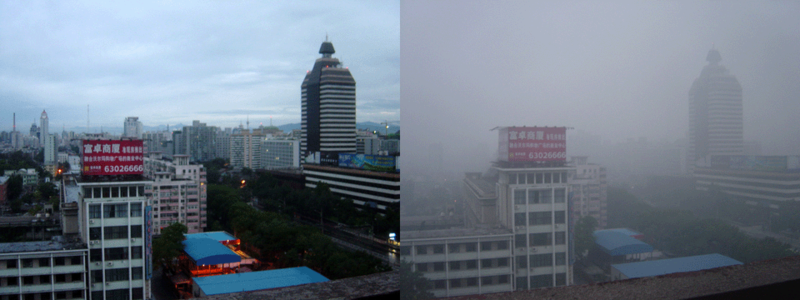Science writer Mark Peplow has been taking the air in Beijing...
Mark - Yeah, that's right. Have you ever been to Beijing, Chris?
Chris - I have. I went in 1999 and I was gobsmacked by the amount of traffic and the number of bicycles on the road. But I've got a very nice picture of myself at the emperor's Summer Palace, looking across the lake to the mountains, the artificial mountains they've built for him in the background, and you can see them very clearly. At the time of the Olympics [2008], someone posted a near identical picture on the internet and that view that I had had, in 1999, was completely obscured. They said that's down to pollution.
Mark - It is. Beijing has a huge air pollution problem. Mostly from the tiny particles that are generated from burning coal and the number of cars on the road as well. So, that's a known public health problem, but there's a lot less known about the impact or even the identity of the microbes that are also drifting through that brown haze and these particular smogs that you get. So, Chinese researchers now use genome sequencing to sample the air and they've identified about 1300 different bacteria that were floating around in a particularly soupy smog back in January last year.
Chris - Okay, but how does that compare with - if I just took some London air or some (heaven forbid) Cambridge air on a day like today and do a similar genome analysis because just because they're there, it doesn't mean that they're either pathological or that they're there in a threshold amount that can do damage?
Mark - You're absolutely right. We live in a sort of microbial soup all the time. Researchers have done some similar genome surveys. It's called metagenomics. Genome surveys of air in a New York subway and in Milan for example. But previously, we haven't really had the technical ability to drill down to identify particular species. What you tend to be able to do is to identify sort of the presence of members of a broad family of bacteria. But of course, the pathogenicity of different members of that family varies quite a lot. Now, what they've done here in Beijing is actually drill down and identify individual types of bacteria, species of bacteria. Most of them are benign, but a few of them are responsible for allergies and respiratory diseases in humans - Streptococcus pneumonia for example was in there and Aspergillus fumigatus which is a fungal allergen. Importantly, what they found was that the amount of DNA from these species actually increased 2 to 4 times on the smoggiest days. So, there's this hypothesis now that on the smoggiest days, you're not only getting exposure to more particles, but potentially, more exposure to pathogens and allergens.
Chris - Of course, people have in the past related bad air days to bad allergy, bad respiratory, and bad heart attack days. There's a very connection and previously, people have implicated nanoparticles in the air from engines and things. So, do you think that the bugs are possibly playing a role as well?
Mark - Well, when I was writing this story this week, I spoke to one researcher in Milan actually who said that there's this growing sense actually that bacteria are playing a really important role in these adverse health effects of airborne particles. There's this growing sense that perhaps bacteria are one of the key factors in causing health problems.









Comments
Add a comment